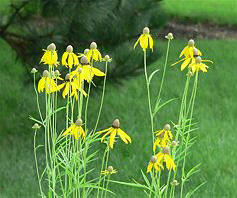A summer perennial favorite, the black-eyed susans, or the Genus: Rudbeckia, is a colorful group of plants that can play a large role in your summer
garden. Not only does the golden color of the flower petals shine, but the activity of birds, butterflies and bees it brings to the garden is well worth a second look. There
are many species of rudbeckias that are native to this part of the United States, and therefore, are very hardy and easy to grow.
 Rudbeckia fulgida 'Goldsturm' was selected as the 1999 perennial plant of
the year by the Perennial Plant Association. 'Goldsturm' is recognized by its ease of growth, adaptability to soils and heavy blooming. This particular rudbeckia does well in
average to dryer soil conditions, full sun for best blooming, but will tolerate a little shade. It's a great cut flower, and can be used as a ground cover and as a mass
planting, due to its ability to reseed.
Rudbeckia fulgida 'Goldsturm' was selected as the 1999 perennial plant of
the year by the Perennial Plant Association. 'Goldsturm' is recognized by its ease of growth, adaptability to soils and heavy blooming. This particular rudbeckia does well in
average to dryer soil conditions, full sun for best blooming, but will tolerate a little shade. It's a great cut flower, and can be used as a ground cover and as a mass
planting, due to its ability to reseed.
Rudbeckia hirta is considered a biennial, but appears to be a perennial because it often will keep coming back - but from seed. This black-eyed susan
may also be called a gloriosa daisy. The daisy-like flower is larger than that of the fulgida species, and the flower itself is probably a bit more showy due to the size of
the flower. But as a mass planting, Rudbeckia fulgida outshines R. hirta.
Rudbeckia maxima, or great coneflower, is an unusual rudbeckia. The foliage is at the base of the plant, reaching about 18 inches. Each leaf can be as
long as 12 - 18 inches and they are grey-green in color. The flower stems shoot up to 6 feet in height, and on top of the spike is a yellow flower with a brown center. The
petals droop from the center cone, resembling that of a coneflower (Echinacea), but as the flower matures, the center cone elongates as much as five inches. This is a very
striking plant when in bloom due to its height.
 Rudbeckia triloba sports a small daisy flower, about one inch across, on
top of a plant that, as a whole, reaches 2 - 3 feet tall. This black-eyed susan is also a biennial, growing a cluster of leaves the first year, flowering the second year,
going to seed, and starting all over again. It reseeds very easily and is good for a naturalizing area as opposed to an area that is more manicured. The seedlings will grow
everywhere, making in difficult to contain if you wish to do so. Place this biennial in a location where it is allowed to "do its thing".
Rudbeckia triloba sports a small daisy flower, about one inch across, on
top of a plant that, as a whole, reaches 2 - 3 feet tall. This black-eyed susan is also a biennial, growing a cluster of leaves the first year, flowering the second year,
going to seed, and starting all over again. It reseeds very easily and is good for a naturalizing area as opposed to an area that is more manicured. The seedlings will grow
everywhere, making in difficult to contain if you wish to do so. Place this biennial in a location where it is allowed to "do its thing".
 Two additional rudbeckia worth mentioning are Rudbeckia lanciolata and
Rudbeckia pinnata. Both are native to the Midwest, and not particularly easy to find in the northeast, however both are easy to grow perennials worth searching out. R.
lanciolata, unlike most rudbeckias, likes moist soils and does particularly well in part sun. It is naturally found in moist meadows along wooded areas and floodplain forests
in the Midwest, so plant it where there is lots of moisture. It reaches 5 - 7 feet in height and the flowers have the typical yellow rays but they surround a green center.
Its leaves are large, about 12" long, and the flowers are about 2 - 3 inches across.
Two additional rudbeckia worth mentioning are Rudbeckia lanciolata and
Rudbeckia pinnata. Both are native to the Midwest, and not particularly easy to find in the northeast, however both are easy to grow perennials worth searching out. R.
lanciolata, unlike most rudbeckias, likes moist soils and does particularly well in part sun. It is naturally found in moist meadows along wooded areas and floodplain forests
in the Midwest, so plant it where there is lots of moisture. It reaches 5 - 7 feet in height and the flowers have the typical yellow rays but they surround a green center.
Its leaves are large, about 12" long, and the flowers are about 2 - 3 inches across.
R. pinnata has drooping yellow rays surrounding a green center cone. The leaves are thin and about
5 inches in length. This rudbeckia is native to the Midwest prairies, so it does well in dryer conditions, and will reseed. As typical of all
rudbeckias, it blooms in July through September. This one will reach 5' in height.
For me, black-eyed susans are a necessity in the perennial garden. The summer color it contributes is difficult to find in any other native plant.
When planning for this yellow -gold color, be prepared for the abundance of plants that will be produced and the added bird, bee and butterfly life it will attract.
Read other articles on ecological gardening & native plants